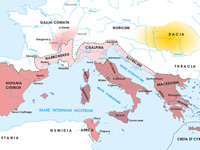Great Roman Civil War (49–45 BC)

War against Pharnaces
After spending the first months of 47 BC in Egypt, Caesar went to Syria, and then to Pontus to deal with Pharnaces II, a client king of Pompey's who had taken advantage of the Romans The Roman Republic was a form of government of Rome and the era of the classical Roman civilization when it was run through public representation of the Roman people. Beginning with the overthrow of the Roman Kingdom (traditionally dated to 509 BC) and ending in 27 BC with the establishment of the Roman Empire, Rome's control rapidly expanded during this period - from the city's immediate surroundings to hegemony over the entire Mediterranean world. being distracted by their civil war to oppose the Roman-friendly Deiotarus and make himself the ruler of Colchis and lesser Armenia. At Nicopolis Pharnaces had defeated what little Roman opposition Caesar's lieutenant, the governor of Asia Gnaeus Domitius Calvinus, could muster. He had also taken the city of Amisus, which was a Roman ally, made all the boys eunuchs, and sold the inhabitants to slave traders. After this show of strength against the Romans, Pharnaces drew back to suppress revolt in his new conquests.
The Roman Republic was a form of government of Rome and the era of the classical Roman civilization when it was run through public representation of the Roman people. Beginning with the overthrow of the Roman Kingdom (traditionally dated to 509 BC) and ending in 27 BC with the establishment of the Roman Empire, Rome's control rapidly expanded during this period - from the city's immediate surroundings to hegemony over the entire Mediterranean world. being distracted by their civil war to oppose the Roman-friendly Deiotarus and make himself the ruler of Colchis and lesser Armenia. At Nicopolis Pharnaces had defeated what little Roman opposition Caesar's lieutenant, the governor of Asia Gnaeus Domitius Calvinus, could muster. He had also taken the city of Amisus, which was a Roman ally, made all the boys eunuchs, and sold the inhabitants to slave traders. After this show of strength against the Romans, Pharnaces drew back to suppress revolt in his new conquests.
Nevertheless, the extremely rapid approach of Caesar Julius Caesar (100-44 BC), was a Roman politician and general who played a critical role in the events that led to the demise of the Roman Republic and the rise of the Roman Empire. Caesar is considered by many historians to be one of the greatest military commanders in history. Julius Caesar » in person forced Pharnaces to turn his attention back to the Romans. At first, recognizing the threat, he made offers of submission, with the sole object of gaining time until Caesar's attention fell elsewhere; Caesar's speed brought war quickly and battle took place near Zela (modern Zile in Turkey), where Pharnaces was routed with just a small detachment of cavalry. Caesar's victory was so swift and complete that, in a letter to a friend in Rome, he famously said of the short war, "Veni, vidi, vici" ("I came, I saw, I conquered"): indeed, for his Pontic triumph, that may well have been the label displayed above the spoils.
Julius Caesar (100-44 BC), was a Roman politician and general who played a critical role in the events that led to the demise of the Roman Republic and the rise of the Roman Empire. Caesar is considered by many historians to be one of the greatest military commanders in history. Julius Caesar » in person forced Pharnaces to turn his attention back to the Romans. At first, recognizing the threat, he made offers of submission, with the sole object of gaining time until Caesar's attention fell elsewhere; Caesar's speed brought war quickly and battle took place near Zela (modern Zile in Turkey), where Pharnaces was routed with just a small detachment of cavalry. Caesar's victory was so swift and complete that, in a letter to a friend in Rome, he famously said of the short war, "Veni, vidi, vici" ("I came, I saw, I conquered"): indeed, for his Pontic triumph, that may well have been the label displayed above the spoils.
Pharnaces himself fled quickly back to the Bosporus, where he managed to assemble a small force of Scythian and Sarmatian troops, with which he was able to gain control of a few cities; however, a former governor of his, Asandar, attacked his forces and killed him. The historian Appian states that Pharnaces died in battle; Dio Cassius says Pharnaces was captured and then killed.
HISTORY

RESOURCES
This article uses material from the Wikipedia article "Caesar's Civil War", which is released under the Creative Commons Attribution-Share-Alike License 3.0.
© Stories Preschool. All Rights Reserved.









